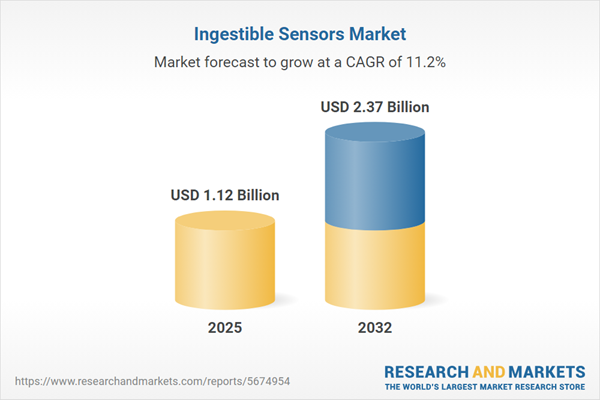Speak directly to the analyst to clarify any post sales queries you may have.
The ingestible sensors market is rapidly reshaping digital healthcare by enabling seamless, real-time access to internal physiological data. This technology empowers healthcare organizations to enhance precision medicine, optimize workflows, and strengthen clinical decision-making, positioning senior leaders to capitalize on advancing digital health capabilities.
Market Snapshot: Growth and Opportunity in the Ingestible Sensors Market
The global ingestible sensors market is on a fast-track growth trajectory, with revenues set to rise from USD 1.01 billion in 2024 to USD 1.12 billion by 2025 and projected to reach USD 2.37 billion in 2032. This sustained expansion is fueled by the rapid evolution of smart diagnostic platforms and their seamless integration into digital health systems. Modernization efforts across healthcare institutions are prompting accelerated adoption, as hospitals, outpatient clinics, and research facilities incorporate ingestible sensors to enhance both care outcomes and organizational efficiency.
Scope & Segmentation: Comprehensive Overview of Ingestible Sensor Solutions
- Product Types: Capsule endoscopes enable internal imaging and navigation for gastrointestinal assessment. Smart pills are designed to detect biochemical markers, pressure, pH, or temperature, supporting efficient clinical integration across varied environments.
- Applications: Use cases include optimizing drug delivery, gastrointestinal tract evaluation, ambulatory care management, and long-term monitoring of vital signs for both clinical and research scenarios. These solutions align with evolving needs in patient diagnostics and remote monitoring.
- End Users: Hospitals, ambulatory surgical centers, diagnostic and outpatient facilities, and research laboratories adopt ingestible sensors to support standard and specialized care processes, enhancing operational capacity and accuracy.
- Technologies: Active sensor modules feature internal power sources to ensure reliable, real-time data capture. Biodegradable sensor designs promote safe post-use dissolution, while inert models are tailored for specific patient populations to enable safer deployment.
- Distribution Channels: Institutional tenders, digital procurement platforms, and retail supply chains allow healthcare organizations to access the most appropriate ingestible sensor solutions by leveraging diverse sourcing models.
- Regional Coverage: The ingestible sensors market reaches North America, South America, EMEA, and Asia-Pacific. These regions demonstrate unique healthcare regulations, adoption rates, and a mix of established and emerging healthcare systems, influencing market penetration and procurement strategies.
- Key Companies: The competitive landscape is shaped by Medtronic PLC, Olympus Corporation, Chongqing Jinshan Science & Technology Group, IntroMedic Co., CapsoVision, Fujifilm Holdings, Otsuka Pharmaceutical, Proteus Digital Health, etectRx, and BodyCAP S.A. These organizations impact the market via regulatory engagement, innovation, and geographic expansion.
Key Takeaways for Senior Decision-Makers
- Ingestible sensors strengthen precision medicine initiatives and facilitate the expansion of remote care by delivering accurate physiological data to healthcare leaders across new care settings.
- The integration of advanced microelectronics and biocompatible materials ensures measurement consistency, improves patient experience, and supports secure data transmission within health IT systems.
- Flexible sensor types permit adaptation to diverse clinical workflows, supporting widespread clinical and research use cases and improving enterprise data management.
- Collaboration among device manufacturers, pharmaceutical companies, and analytics partners continues to drive the pace of medical sensor technology innovation and expand international uptake.
- Regional differences in regulation and reimbursement models directly influence procurement decisions and overall adoption rates, with Asia-Pacific health systems witnessing significant momentum as digital therapeutics progress.
- The trend toward modular sensor design, along with rigorous compliance verification, streamlines evaluation for stakeholders and facilitates more efficient alignment with regulatory standards.
Tariff Impact: Navigating Supply Chain and Cost Shifts
The introduction of new U.S. tariffs in 2025 will result in elevated duties on essential components including semiconductors and polymers, which are foundational to ingestible sensor technology. Manufacturers are actively adapting sourcing models by prioritizing domestic and allied suppliers, aiming to reduce exposure to supply chain disruptions. Emphasizing collaborative relationships with suppliers and diversified sourcing, manufacturers seek to maintain innovation momentum while navigating regulatory guidance to ensure business continuity during supply chain adjustments.
Methodology & Data Sources
This market analysis combines expert interviews across clinical, technological, and regulatory domains with insights derived from peer-reviewed literature, patent data, market surveillance, and compliance documentation. Careful segmentation and triangulation yield actionable, sector-focused intelligence for organizational strategists.
Why This Report Matters
- Actionable segmentation and current market insights support strategic procurement, investment, and business development initiatives in diverse healthcare regions and applications.
- The report prepares senior leaders to respond to evolving regulatory requirements and changing supply chain scenarios affecting digital health deployment.
- Clear, sector-aligned intelligence strengthens competitive positioning and informs valuable partnership decisions in the dynamic medical sensor marketplace.
Conclusion
Forward-looking organizations leveraging ingestible sensor technology and adaptive strategies will be positioned to drive the evolution toward data-centric, digitally enabled healthcare operations.
Additional Product Information:
- Purchase of this report includes 1 year online access with quarterly updates.
- This report can be updated on request. Please contact our Customer Experience team using the Ask a Question widget on our website.
Table of Contents
3. Executive Summary
4. Market Overview
7. Cumulative Impact of Artificial Intelligence 2025
List of Figures
Samples

LOADING...
Companies Mentioned
The key companies profiled in this Ingestible Sensors market report include:- Medtronic PLC
- Olympus Corporation
- Chongqing Jinshan Science & Technology Group Co., Ltd.
- IntroMedic Co., Ltd.
- CapsoVision, Inc.
- Fujifilm Holdings Corporation
- Otsuka Pharmaceutical Co., Ltd.
- Proteus Digital Health, Inc.
- etectRx, Inc.
- BodyCAP S.A.
Table Information
| Report Attribute | Details |
|---|---|
| No. of Pages | 185 |
| Published | October 2025 |
| Forecast Period | 2025 - 2032 |
| Estimated Market Value ( USD | $ 1.12 Billion |
| Forecasted Market Value ( USD | $ 2.37 Billion |
| Compound Annual Growth Rate | 11.2% |
| Regions Covered | Global |
| No. of Companies Mentioned | 11 |









